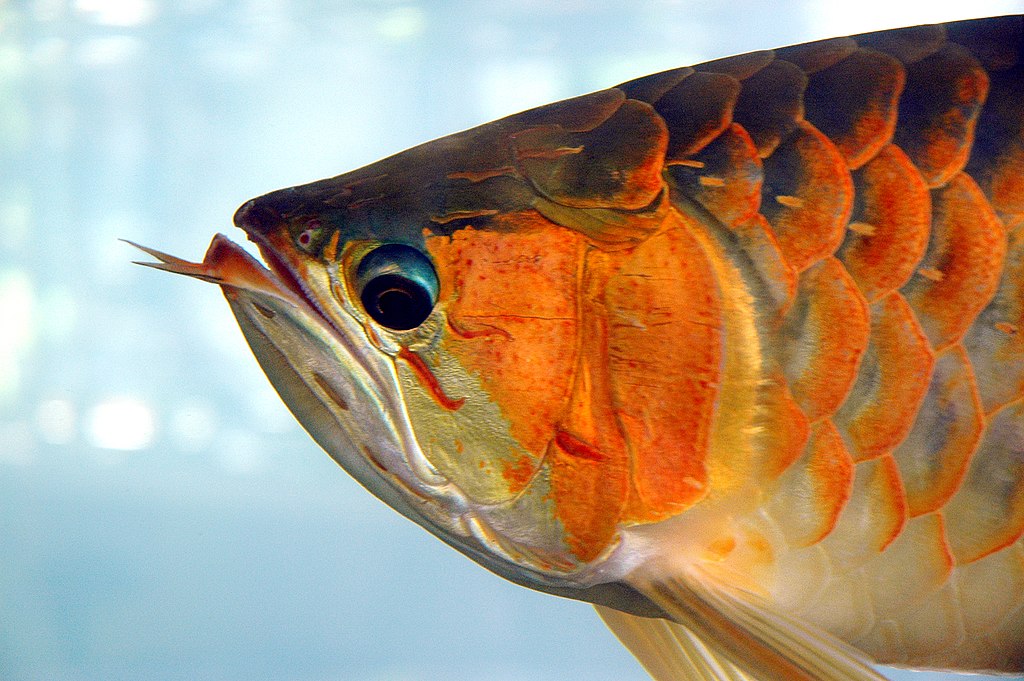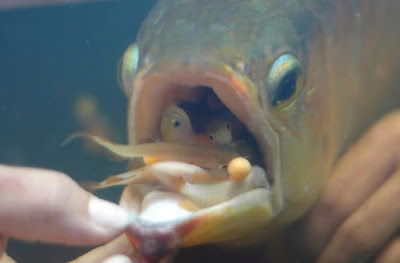Water
monkeys that
Will outgrow aquaria
Do
not buy or sell!
The
Asian Arowana Scleropages formosus (Müller
& Schlegel, 1844) is also known as the Golden Dragonfish or Golden
Arowana. In the Indonesian language, arowana
means “the fish of paradise.” However,
this prized symbol of feng shui, has been driven towards extinction. It lives in flooded forests, swamps, and
sluggish rivers at very low densities throughout its range in southeast Asia. Low densities are largely due to poaching in the international aquarium trade, draining swamp habitats for
agriculture, and logging swamp forests.
 |
| Asian Arowana Scleropages formosus |
Asian
Arowana are captured by subsistence fishers, who seldom eat them. Rather they keep it alive to sell the fish
for aquarium trade. Trade of the Asian
Arowana is restricted, but the fish is so highly valued that wild-caught
specimens are frequently illegally sold.
Why
its illegal to sell this fish? Asian Arowana are endangered under the
Convention on Trade in Endangered Species (CITES) and the US Endangered Species
Act. Breeders in Indonesia and Malaysia
must be licensed and registered with the CITES Secretariat. Each Asian Arowana that is exported must be
microchipped and proof of certification must follow a process approved by
CITES. In order to import an Asian Arowana, you would need a permit from the US Fish and Wildlife Service, in order to justify your use. Leave that to the large, pubic aquariums. Asian Arowana may live for many decades and
require very large aquaria (many hundreds of gallons) in order to thrive. A San Diego man was convicted of illegally importing Asian Arowana and others are frequently prosecuted over illegal trade in arowanas.
Asian
Arowana are specialized surface feeders with a large mouth and eyes that have binocular vision. They can eat any type of fish. The tip of the lower jaw has large protruding barbels that are filled with taste buds. The sensory barbels aid in feeding in murky waters. They are also able to leap from the water to capture insects and spiders. Examination of their
guts indicates they sometimes eat birds, bats, and snakes. This leaping
behavior explains the name “water monkeys.”
Warm swamps or sluggish rivers with frequent periods of low oxygen are
favored habitats of the Asian Arowana, which are facultative air breathers. They have vascular tissues in swim bladder.
 |
| Asian Arowana (close up of head) showing the large protruding sensory barbels. Photo by Marcel Burkhard (Creative Commons) |
This beautiful fish will be
difficult restore to its native habitats due to pervasive habitat changes in southeast Asia (Koh et al. 2013). The Freshwater Fisheries Research Station
(FFRC) in Malaysia successfully bred the Golden Arowana in captivity in
1996. During courtship
the male chases the female and sometimes the pair swims together in a
circle. The pair eventually swim side by side with
bodies touching, and the female releases a cluster of large, reddish orange eggs
that are immediately fertilized by the male.
But the male’s parental role is not over yet. The male scoops up the fertilized eggs into
his mouth, where he incubates them until fry hatch and can swim
independently. The mouth-brooding male
is busy with these chores for about 8 weeks.
 |
| Arowana fry being released from mouth of parental male. Photo source. |
In wild populations, the color is usually silver with hints of red, gold, green, black, and/or blue. Colors vary among differing populations of Asian Arowana, as some populations became more isolated after sea levels rose in the Pleistocene. Breeders cross varieties and create different colors in Asian Arowana, in particular the vibrant reds and golds that are most desired. Recently, a team of scientists sequenced the genome of the Asian Arowana and identified 94 genes that may influence the color patterns (Austin et al. 2015).
 |
| Young Asian Arowana in the mouth of parental male. Source. |
The
Asian Arowana is a part of a very old lineage of early bony fishes that arose on the ancient supercontinent of Gondwana, which broke up 180
million years ago. The Osteoglossomorpha
are fishes commonly referred to as bonytongues, because of the teeth on the
tongue and roof of the mouth. Other
well-known bonytongues fishes include the Mooneye, Goldeye, Arapaima, Elephantfishes, and the featherback knifefishes. Today, we need to preserve
and protect the remaining populations of the Asian Arowana so that there will
be founders to restore wild populations. Don't be tempted to buy an Asian Arowana.
Let’s ensure that this symbol of good luck and prosperity has a future
as long as its past.
References
Austin, C. M. et al. 2015. Whole genome sequencing of
the Asian Arowana (Scleropages formosus)
provides insights into the evolution of ray-finned fishes. Genome Biology and Evolution 7(10): 2885-95; doi:
10.1093/gbe/evv186
Koh, L.P., D.
Sheil, T.M. Lee, X. Giam, L. Gibson, and G.R. Clements. 2013. Biodiversity
state and trends in southeast Asia. Chapter 357 in Encyclopedia of
Biodiversity, Volume 1.
Kottelat, M. 2013.
Scleropages formosus. The IUCN Red List of Threatened Species 2013:
e.T20034A9137739.
http://dx.doi.org/10.2305/IUCN.UK.2011-1.RLTS.T20034A9137739.en. Downloaded
April 15, 2016



No comments:
Post a Comment